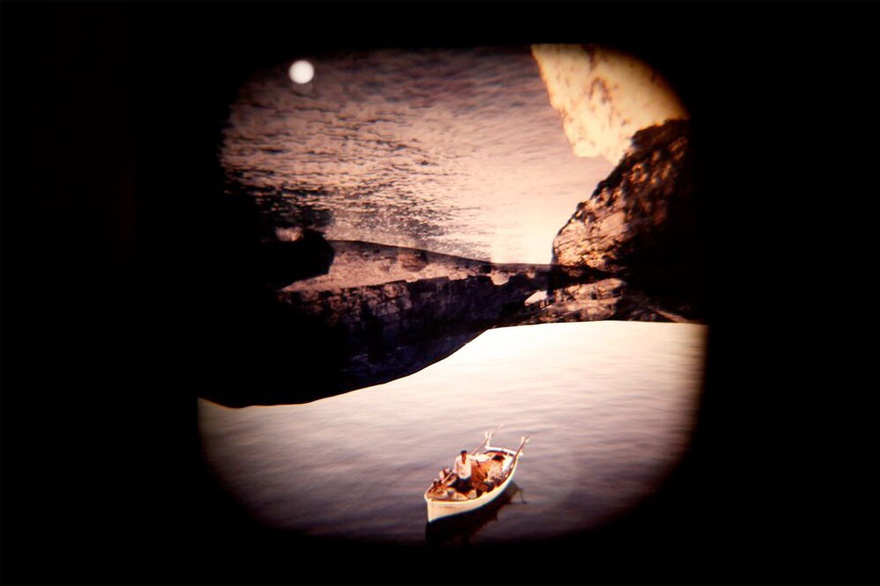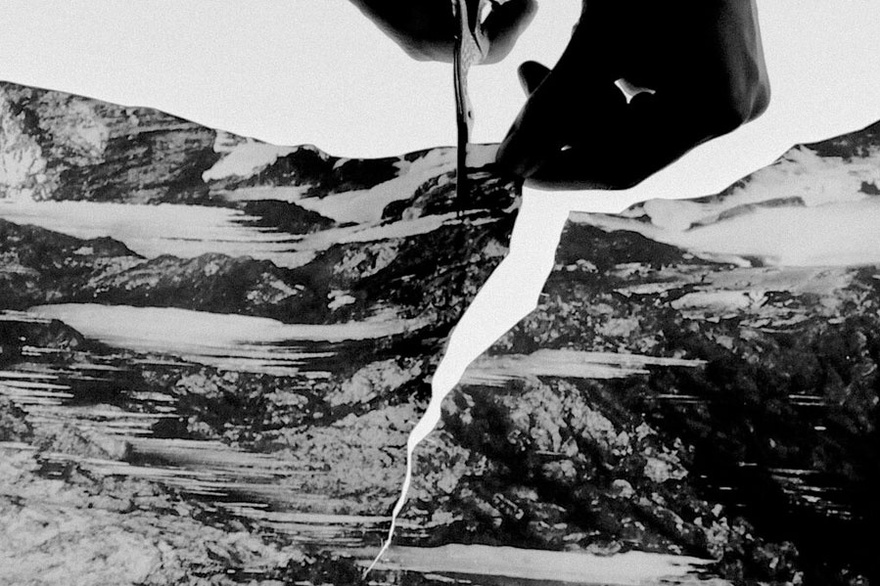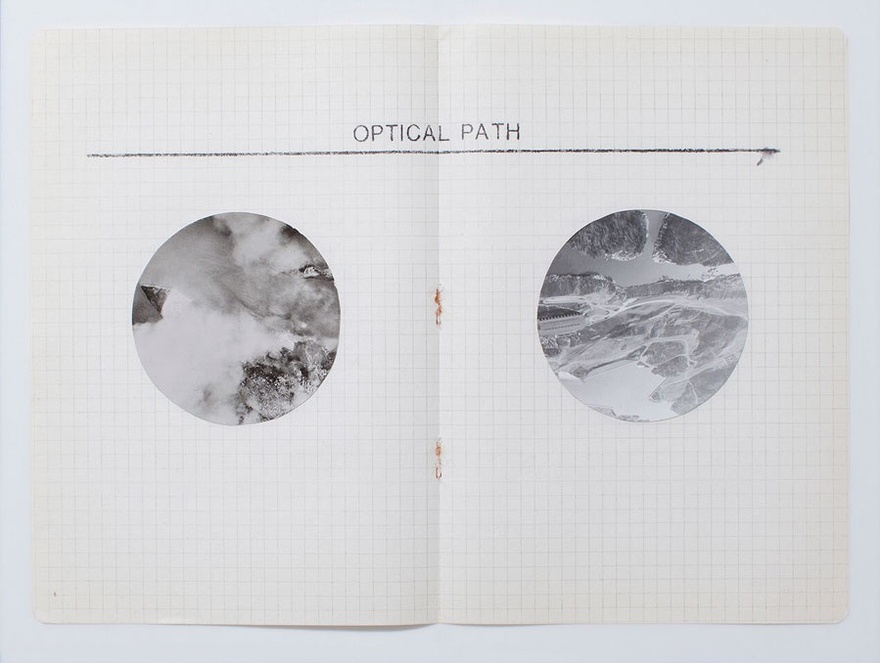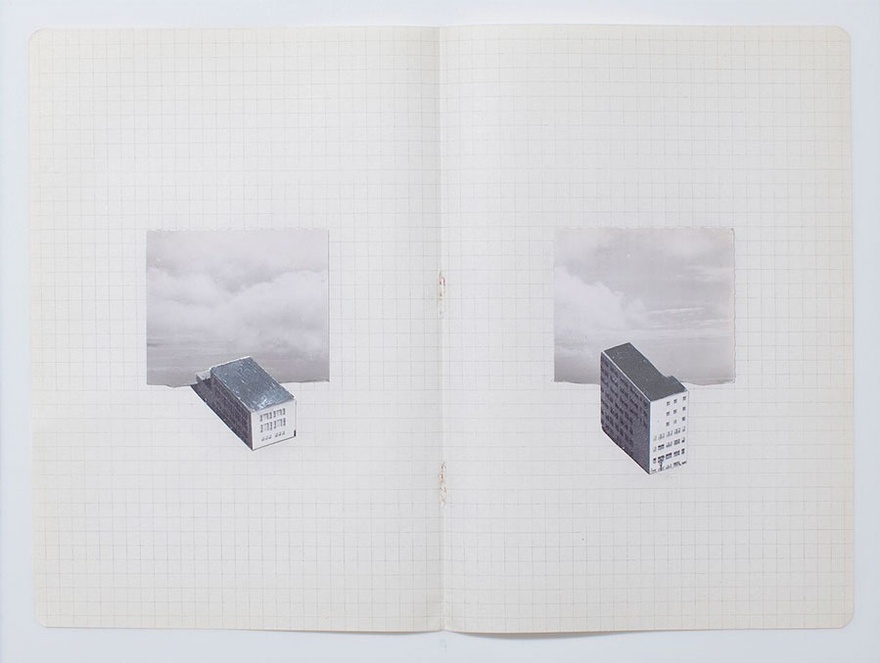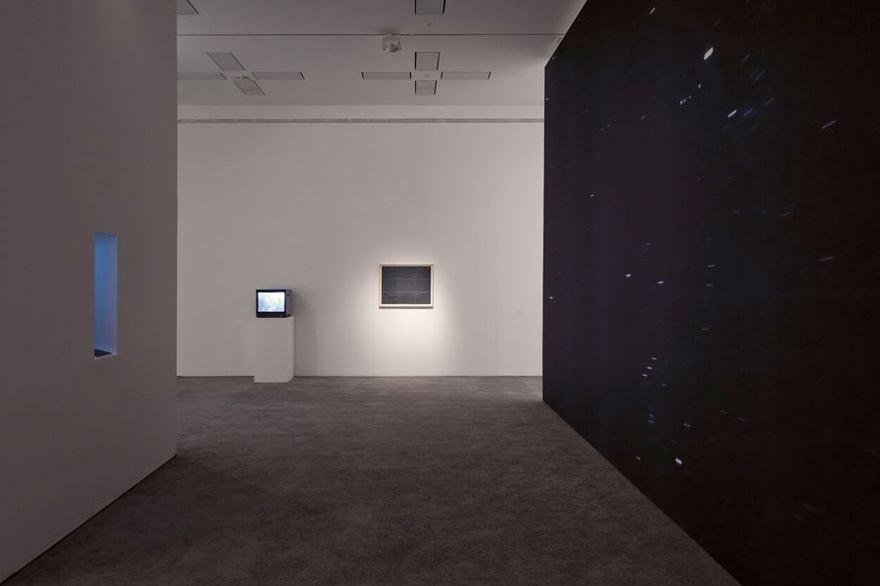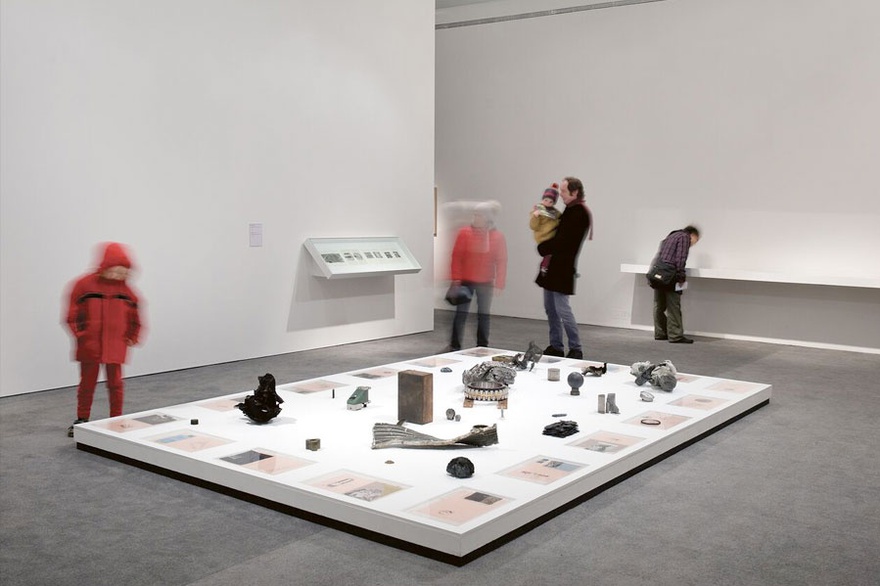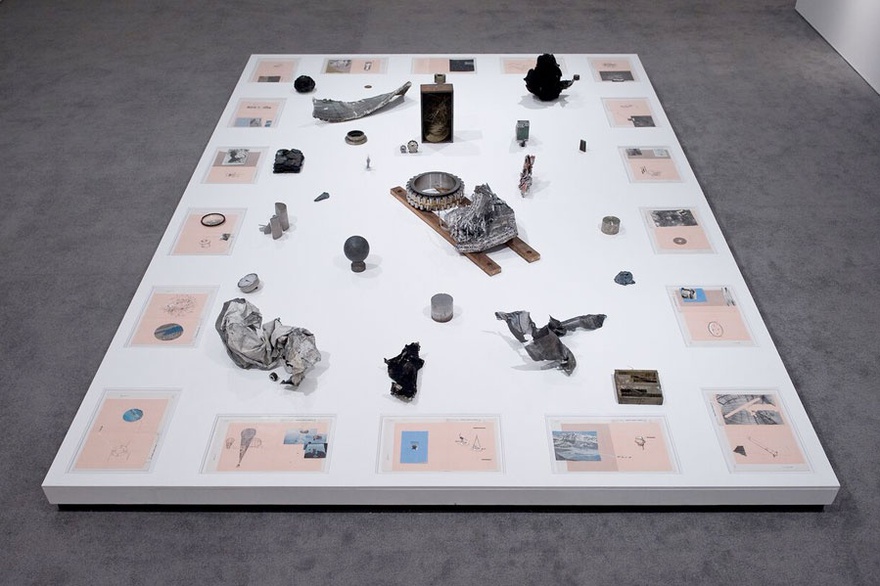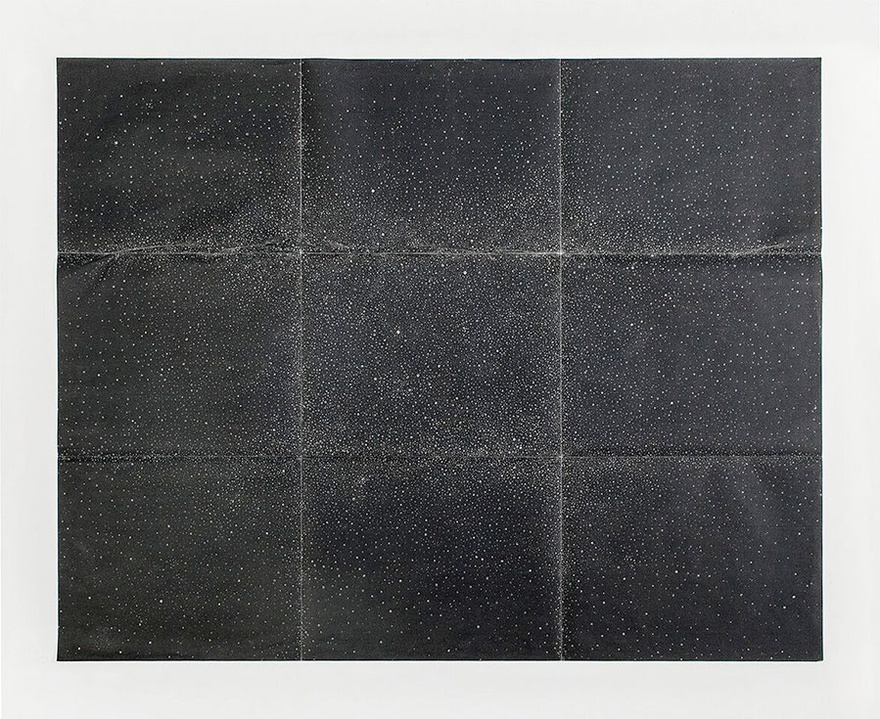Interviews
Systems of Fragments
Hajra Waheed in conversation with Stephanie Bailey
This interview takes two exhibitions Hajra Waheed staged in the UK in 2016 as a starting point through which to explore Waheed's expansive practice: Sea Change, Chapter 1: Character 1, In the Rough, at London's Mosaic Rooms, and The Cyphers at BALTIC Center for Contemporary Art in Gateshead. At The Mosaic Rooms, Waheed presented the story of a man on the search for quartz: the first chapter of a project that has been ongoing since 2011, in which the artist has created nine characters who each form the subject of one of nine chapters. At BALTIC, Waheed showed The Cyphers, a project that brought together new and older works, that represented a development on Still Against the Sky, a solo exhibition and incubator project staged at the KW Institute for Contemporary Art in Berlin in Fall 2015, curated by Natasha Ginwala. Shown on the BALTIC's ground floor, the exhibition was themed around militarization and aerial surveillance – themes that intertwine with Waheed's own background growing up in a heavily guarded Saudi ARAMCO compound in Saudi Arabia, before moving to the United States for a decade then back to Canada in 2005.
Stephanie Bailey: You have described your project Sea Change, which was conceived in response to an event in which 166 pilgrims from Kolkata disappeared on their journey to Mecca, as a visual novel 'dedicated to reclaiming a sense of the intimate, the personal and the poetic from the consequences of regional development, political upheaval, and civil conflict'. The ongoing project, commenced in 2011, presents a fragmented, abstract narrative presented over nine chapters, corresponding to the nine characters you have created for the story.
At your Mosaic Rooms exhibition in 2016, you presented Chapter 1: Character 1, In the Rough, through which we meet an individual on the search for quartz, with the project making reference to the fact that 'US company General Time Corporation had, under contract by NASA, used quartz crystal for obtaining a stable time base from which all mission times could be derived' – a fact that highlights the crystal's 'unfaltering' and 'unsurpassed' ability to conduct heat, light and ultraviolet rays. You represent the search for the quartz in this project through a series of works and installations that include field notes, archival photographs taken from a large deck of 1930–40s photographic postcards, and drawings, all of which give the impression of a mad scientist of sorts.
I wonder if you could elaborate on the project's themes of transformation, love, and longing, and how the specific iteration at The Mosaic Rooms elaborated on them?
Hajra Waheed: Sea Change, which I can only best describe as a visual novel, came to fruition after years of collecting news reports of disappearances. In December 2011, I became fixated on one particular account in which 166 pilgrims from Kolkata left for Saudi Arabia on the pretext of making the Hajj but later and upon head count, were nowhere to be found. The disappearance was quickly overlooked in the media but the story stayed with me. Since then, Sea Change has grown to encompass a larger narrative that revolves around nine protagonists over nine chapters – nine stories of transformation. Much like the flotsam and jetsam of a shipwreck, thousands of fragments over a lifetime will come together to form these visual memoirs. I suppose I'm interested in how epic journeys and epic desires can both pacify and obliterate us. The larger themes of longing, loss and transformation upon which Sea Change is founded, chronicle several journeys in search of something greater than oneself. As the body of work continues to unfold, it is my intention that viewers will gain a deeper and a more intimate understanding of each character, their motivations and their journeys – whether taken by choice or made by force.
The Mosaic Rooms exhibition brought together a large selection of works from Chapter 1: Character 1, In the Rough for the first time. It was organized into three distinct rooms, one leading into the next, giving viewers a sense of an evolving narrative. The works shown were composed of fragments of images, scribbled text and found objects that provided clues to the chapters' central character – his profession, possible national origin, bloodlines and romantic entanglements. They oscillate between the language of classification – in this case related to excavation – and a more poetic, intimate register, such as love letters. I am often asked about whom the love and longing in this first chapter should be attached. But the definitions here are expansive, meaning that it can be read as love between two persons and more broadly between one individual and their sense of home or belonging.
SB: The exhibition reflects your resistance to offering linear narratives in your work, and I wonder how this extends to the project as a whole, and your relationship to it?
HW: I've never managed to tell stories in straight lines. I see both my life experiences and work as a constellation of interrelated narratives. Rather than approach my practice as a series of individual projects with a set beginning, middle and end, I prefer the formal logic of novels and poems. Although even these forms rely on some degree of linearity, they also leave room for interpretation, hint at incompleteness, and allow readers to fill in the blanks. Resisting straightforward linearity means allowing viewers the opportunity to take different routes through the work, spend time with the spaces in between and ruminate on vague yet important subtexts and undercurrents.
I do of course rely on linearity to some extent as the framework upon which a web of fragments hangs, and in order to engender a feeling of anticipation in terms of where the story will take its characters. There is a sense of gradual unfolding or movement, as in the chapters of a novel, but I always avoid conclusiveness or containment and leave the direction of the narrative purposefully unclear.
SB: How does this play between a grounded origin and an abstract interpretation relate to your own positioning as an artist, and how you position yourself both within the work, and around it?
HW: I'm prompted in equal parts by extensive research, collective memory and relevant personal experience. The personal enters my work by way of an intuitive approach to artmaking. So often artists are expected to collapse seamlessly into their work; viewers are always looking for legible signs of the personal or autobiographical in order to gain a foothold on understanding works that are either formally sparse or, in my case, intentionally sprawling and recontextualized.
Over explaining Sea Change inhibits and hinders its interpretation and experience. Often writers will come up with much more in-depth analyses given the material traces left from the project rather than a verbal explanation from me. I'm unfolding a narrative over many years so there is a necessary need to shroud the details in order to preserve a sense of uncertainty. Who wants to begin a novel to which they are already privy its end? More importantly, over explanation reduces people's agency as thinking and feeling bodies. I'm far more interested in interpreting through experience as opposed to relying solely on textual research as a means of experiencing the work.
I suppose I mediate what to divulge and what to hold onto by being selective with interviews and fielding particular types of questions. When it comes down to it, I'm a private person who struggles with how little privacy we have in a world today that demands, expects and rewards transparency and digital accessibility.
SB: This privacy relates in some way to The Cyphers, your exhibition at the BALTIC in Gateshead, which expands on a project you recently showed at KW Institute for Contemporary Art, Berlin, Still Against the Sky. The project considers the militarization of the sky through the control of military drones and surveillance technology, and is often described in relation to your upbringing in the gated community of Saudi ARAMCO in Saudi Arabia, where you are said to have 'developed a childhood obsession with identifying aircraft, tracking flight routes and keeping logs' in a highly restricted environment – I read that it was protected by U.S. and Saudi air bases, the CIA, the Saudi secret service, and a private in-compound security force.
How does the BALTIC show relate to and build on Still Against the Sky?
HW: Still Against the Sky, curated by Natasha Ginwala, was a solo exhibition and incubator project held at the KW Berlin in Fall 2015. Works from this show traveled onwards and were met with others at the BALTIC Centre for Contemporary Art, UK where they were reconfigured into an exhibition The Cyphers, curated by Alessandro Vincentelli, curator of exhibitions and research at the BALTIC.
The Cyphers expanded on my long-standing relationship to and inquiries around our current aerial occupation, highlighting the ever-increasing militarization of sky and space, where the circulation of drones and surveillance technology extends itself over everyday life, often with lethal consequences. I combined collage, video, sound and sculpture to explore the larger codes and operations of security and surveillance from an intimate perspective, pointing to the existential questions that constantly arise, having lived under the shape-shifting gaze of the roving eye over a lifetime. I've always been interested in the civilians' role in this paradigm of control – a vertical control that has begun to preside over our very understanding and imagining of the world. Much of what was exhibited at the BALTIC played with unfamiliar points-of-view, from the perspectives of a spinning, falling or roving object to that of an omnipresent entity looking down from above.
SB: Could you talk about the various works you brought together in Gateshead? There are the Drone Studies, for instance, which includes Architectural Studies 1-17, studies on aged paper that present cut out details from a U-2 spy plane shot down over Russia in 1960 along with floor plans from important historical mosques; and pages from The Scrapbook project, which includes drawn transfers depicting geometric patterns, paintings of flowers, collages, and drawings, including a study of Oum Kalthoum.
HW: The exhibition brought together new, recent as well as a selection of early works. Prior to mounting the show, Alessandro spent five days living at my studio in Montreal where we worked closely to further develop the exhibition and its various elements. At that time, he happened to come across works from very early on in my practice (made between the ages of 17 and 23) and asked to open the BALTIC show with Satellite, a work from 2003 that had never been seen nor shown before.
All of the works shown at the BALTIC exhibition were infused with themes of militarism, covert power, mass surveillance and coded languages, as well as control as it is exercised through systems of mapping and data collection. Signed R.E. Moon 1–24 (2015), called into question the legitimacy of official documents, which appear in the works as neither real nor fabricated, combining automation with a hand-drawn quality, while From Blimps to Bugs 1–4 (2010), Aerial Studies 1–8 (2013) and KH-21's – Notes 1–32 (2014) utilized the imagery and technical classifications of research documents and aircraft manuals. In an adjacent set of rooms, The Scrapbook Project 1/3 (2008-2010), which comprised of 35 framed pages of a visual diary made up of drawn and collaged memory fragments, brought these themes down to human scale while its sister project, the Video Installation Project 1–10 played on loop nearby; a sequence of 10 vignettes filmed between 2011 and 2013 in locations where photographic and videographic documentation is prohibited. These micro-narratives, developed as discrete exercises in observation, capture beauty in the banal and surprise in everyday routine. None of the work is staged; all vignettes are filmed from an observational point of view reminiscent of CCTV footage. Viewers are left to decide whether each scene is benign, censored, objective, misdirected or purely speculative.
The Cyphers 1–18 (2016) – a new work and the exhibition's namesake – debuted at the show's centre. The installation consisted of a large platform bearing a number of metal objects that appear to have fallen from the sky, possibly as debris from an explosion. These unrecognizable fragments, accompanied by drawings and collages, imbued an inherent violence. Their physical presence conjured the notion that stories and events only exist if they are registered, recorded and recounted.
Finally, bookending the exhibition was Still Against the Sky 1–3 (2015), which the KW Berlin exhibition was named after and centred around. They are three works on paper – all dimpled with stars against a black sky and folded into quarters. The universes depicted here appear expansive but are equally pocketable, collapsible perhaps even manageable.
SB: It's interesting that you describe the universes in Still Against the Sky as 'expansive' yet 'pocketable' and 'manageable' as it seems to express the dynamics you have honed in your work, which is this constant oscillation between particular and general. For example, as you said, you evade and field certain questions, preferring for the work you make to speak for itself, and to give space for viewers to have their own experiences and construct their own narratives. Yet your work is also very tied to your biography as a child growing up in Saudi Arabia, and later in Canada, and how you have had to, borrowing the words of a recent interview with White Review, UK, 'approach [your] work and process experiences from a specific subject-position that encompasses being a woman, woman of colour with complex ties and relationships to North America, the Middle East and South Asia, born of Muslim immigrant parents.'
This makes me think very much of Sea Change, and the character of the geologist in particular that you created, who embodies this condition of being lost and searching for something as enduring or as stable as a quartz. Looking at the breadth of work on show at The Cyphers, and this sense of walking through the results of various investigations surrounding interlinked themes, it is as if you are inhabiting the role of that very character in Sea Change Chapter 1, but at the same time you create this kind of 'quest' for your viewers, too, framing the audience within an active role of investigator, scientist, or explorer. I wonder if you could expand on the way you mediate your biography, which is often used to frame your work, and how you use it and almost displace it in order to pose questions surrounding personal, national, and cultural identities that you explore?
HW: The importance of quartz immediately came up during the oral telling of this story. The US company General Time Corporation had, under contract by NASA, used quartz crystal for obtaining a stable time base from which all mission times could be derived. Because the crystal's vibration remains unfaltering, quartz clocks are amongst the most precise timekeeping devices, losing less than one hundred thousandth of a second each day. Quartz was considered the first lens on the planet and is also an unsurpassed conductor of heat, light and ultraviolet rays due to its ability to direct light rays through bends and angles. It remains an ideal component of precise scientific equipment for which to explore what lives above and below us.
As for mediating my own identity and background in the work, I don't know any other way of working than to frame it within larger, more dispersed narratives and semi-fictions. As abstract as it may seem sometimes to viewers, to those with an intimate knowledge of my personal life and practice, the work is as legible and revealing as a diary. I want to maintain a certain ambiguity in the oral histories that surface in my work, partially because I think that mystery better serves the work's reception, and partially because I don't believe those oral histories are mine to tell in their entirety. While telling these stories is a way of reclaiming the lost, telling too much can do its own damage. None of the narratives in my work are entirely fictional, although they have been consistently characterized as such in writing about my work.
SB: How does your work relate to artists of the California school, such as Ed Ruscha, who you encountered as a student at the Art Institute of Chicago? It is written that you found an affinity between the gated community in Saudi Arabia that you knew as a child, and the landscapes that these artists depicted.
HW: I spent much of my childhood in a kind of gated corporate Levittown – a surreal replica of a 1950s southern California suburb but in the desert along the Persian Gulf. All the trappings of the American suburb – from identical pre-fab houses, to hedge-lined lawns and in this case, Halliburton-sponsored ballparks could be found there. When I later studied at the Art Institute of Chicago, I became obsessed with the California painters and photographers-Ed Ruscha, included-because their way of imaging the encroachment of suburbia upon the desert landscape of the American west gave rise to a complicated nostalgia. Ed Ruscha was documenting the modernization of desert landscapes in a familiar visual language with his simple taxonomies: of swimming pools, gas stations or abandoned motels. They seemed to present a measured response to a bourgeois utopia and its discontents, the chaos of empire and industrialization. Repetition, aerial views, fragmentary images and seemingly objective documentation are all strategies that were fortified in my work early on and furthermore as a result of these influences. That said, there will always be an obvious chasm between myself and the California artists that influenced me: they are canonized white male painters, after all, representing an exclusionary middle America.
SB: I asked the last question with the spectre of colonization in mind, the impact of which hangs over much of your practice; how does this feed into the ways you employ abstraction and figuration as a way to consider the sense of displacement inherent to the colonized experience? Of course, much of your work is about expanding on the very notion of colonization itself, turning it into an affective, personal memory that resonates differently to all.
HW: My intention is often to prompt affective responses to the colonized experience through the use of found or gifted materials, as in my works re-contextualizing 1930s–40s-era orientalist photographic postcards. I rely on the physicality of objects and their status as vessels of experience to bring a sense of embodied history to my projects. Some of my works deal explicitly with the notion of what is lost, or those who have gone missing; in these cases I use systems of fragments to recreate the negotiations that take place between visibility and invisibility, which are symptomatic of the experiences` of displaced individuals.
SB: Could you expand on this idea of displacement, which seems to lie at the core of your projects, especially in terms of composition? 'Systems of fragments' is a very good way of describing the logic behind your work, with projects created and arranged in such a way that, as you have noted, viewers are left to decide for themselves what they mean in relation to the narratives you explore in your work.
HW: The displaced body is a mind and heart at exile from one another. It's the fluctuating state of being – involuntarily shattered in two or three or four parts or more just to be temporarily relocated, only to later be entirely uprooted. We are only ever parts of ourselves, fragments of a whole. Attempting to chronicle, catalog and compile these selected parts, similar but never identitical to eventually form a – is one way I've managed to work over the years in order to address this state.
SB: How does this relate to The Anouchian Passport Portrait Series (2010– )? This is made up of pencil and charcoal renderings you created by taking on the movement of a printer, marking the paper's ridges by moving from left to right. These renderings reproduce portraits of men and women taken by the Tripoli-based Armenian photographer Antranik Anouchian (1908–1991), which are kept in the archives of Beirut's Arab Image Foundation. You divide these portraits into various categories, including 'Men with Glasses' and 'Women with Headscarves', treating them like echoes of a history in Lebanon that has since passed: 'captured', as writer HG Masters noted, 'by a man who himself escaped the mass obliteration of the Armenian people in 1915–1917.'
How did this project come about, and how did you come to the idea of creating this kind of response? This question also relates to a question I asked above, which is how you mediate different identities and contexts, while also responding in kind with your own.
HW: I first came across an exhibition called Mapping Sitting: On Portraiture and Photography in 2002 at The Gray Art Gallery in New York, featuring over 3600 studio portraits from 1935–1970: ID photos used for official documents, passports and licenses. As you say, the images were culled from the studio archives of Armenian photographer Antranik Anouchian. I felt an affinity to Anouchian, who was displaced and living in exile in Tripoli while these studio portraits were taken. His simultaneous insider/outsider status allowed him to document a more honest representation of the modernization of Lebanon, at a time when other representations relied on either a nostalgic preservationist past or an exoticized colonial vision.
The images in the exhibition were displayed in the form of a large mural that from a distance seemed a blur of nameless faces, but upon closer inspection revealed the distinct features of individuals organized into arbitrary typologies: men with glasses, women with short hair, for example. Growing up in Saudi Arabia, a passport was a document loaded with significance. A male guardian was required to sign off on a woman's passport in order for her travel outside the country or from one city to the next. And so the passport photo became literally and symbolically very important for me, inscribed with what it means to move across borders, what it means to be regionally identified. The Anouchian Passport Portrait Series speaks to how image-making shapes belonging, and how official documents of this kind continuously straddle the line between identity and anonymity. The Mapping Sitting project resonated with me, but it wasn't until years later that I decided to take these sets of images and translate them to the realm of drawing, further blurring the identities of those depicted. From a short distance, the features of each subject are delineated clearly, but upon closer observation they begin to pixelate and blur – an inverse nod to the installation that inspired the work.
These works imply a direct relationship between the state and the individual, the bureacratization of the every day, a sense of order and the attainability of information, while also simultaneously reaffirming that despite the mapping, classifying impulse of the official portrait, identity is an inconstant, shifting phenomenon. National identity especially cannot be pinned down; state borders are porous, even as they are constantly being reimagined, redrawn, re-negotiated and tightened. Within such a context, the subjects of these photographs remain unknown; they are all lost, with what is left being the material trace of the photograph and the associations each of us personally transposes onto them.
Hajra Waheed's multidisciplinary practice ranges from interactive installations to collage, video, sound and sculpture. Prompted by news accounts and extensive research, Waheed uses complex narrative structures to explore issues surrounding covert power, mass surveillance, cultural distortion and the traumas and alienation of displaced subjects via mass migration. Over the last decade, Waheed has participated in exhibitions worldwide, most recently including: The Eighth Climate (What Does Art Do?) 11th Gwangju Biennale, KR (2016); The Cyphers, BALTIC Centre for Contemporary Art, Gateshead, UK (2016); Still Against the Sky, KW Berlin, DE (2015); L'avenir, La Biennale de Montréal, Musée d'art contemporain de Montréal, QC (2014); Sea Change, Experimenter, Kolkata (2013); (In) the First Circle, Antoni Tapies Foundation, Barcelona and Lines of Control, Herbert F. Johnson Museum of Art, NY (2012). She is the recipient of the 2014 Victor Martyn Lynch-Staunton Award for outstanding achievement as a Canadian mid-career visual artist and shortlisted for the 2016 Sobey Art Award, Canada's preeminent contemporary art prize. Hajra Waheed's works can be found in a number of permanent collections including the Museum of Modern Art, New York; British Museum, London; Burger Collection, Zurich/Hong Kong and Devi Art Foundation, New Delhi. She lives and works in Montréal.

